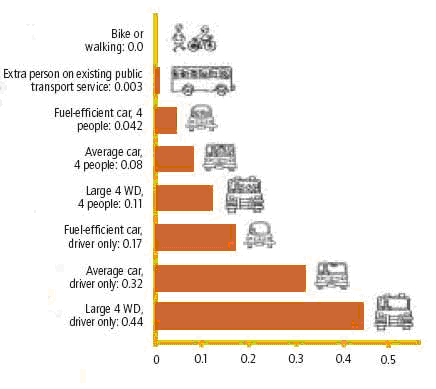Persuading voters to change from travelling by car to using mass transit would yield enormous environmental as well as health-benefits. Unfortunately for Mother Nature, and for those with respiratory complaints, public transport policies do not command headlines. Nor do they grab the imagination. They play best to the inner city types, but will not significantly perk up Labor’s vote, given these voters are, in the main, already committed to the ALP. Put simply, there are no more votes in mass transit polices for Labor, hence the focus on fleeting issues like solar pork.
Motor vehicles are regarded by many as Enemy #1 when it comes to polluting the atmosphere. To reduce the harm they generate, one of three approaches can be adopted:
- convincing the public to drive less or use a lower emission car (such as Toyota’s wonderful Prius);
- have drivers use low emission fuels; or
- improve the economy of fuels available for sale.
Advertisement
The easiest option to promote is the first one: convince, or more correctly persuade, the public to drive less. If we took the money that Labor proposes to spend on Solar Schools and used it to promote greater utilisation of public transportation, would we get a bigger payoff in the volume of greenhouse gasses saved? Let’s see.
The Federal Government’s Australian Greenhouse Office (AGO) enumerates the kilograms of greenhouse gasses emitted per person per kilometre travelled using an array of transportation modes.
The figure below shows just how environmentally unsound private transportation is. When comparing a one-person car to a one-extra-person on mass transit system, the CO2 emitted is 107 times as offensive (based on the AGO figure below that shows that 3 gm of CO2is emitted per person per kilometre travelled on public transport and 320 gm per person per kilometre in a car). I have no background in environmental science, but 3 gm seems exceptionally low and this number is at odds with British estimates of 50 gm of CO2 emitted per person per kilometre travelled by rail. That said, I have employed the (higher) British estimate in the calculations that follow. Even at 50 gm of CO2 per person per kilometre, it’s abundantly clear that a policy of sweet talking citizens out of their cars and onto mass transit should be applauded. So the question is: on the basis of CO2 gas saved, how does subsidising mass transit compare to the Solar Schools initiative.

Kilograms of greenhouse gasses emmitted per person per kilometre travelled using an array of transportation modes.
Source: http://www.greenhouse.gov.au/gwci/transport.html
As an example of a mass transit system that can be better utilised, let’s look at NSW Rail Corporation. As more and more people are persauded to leave their cars at home and hop on public transportation instead, total greenhouse emissions are set to fall.
Advertisement
The following points emerge from a study of the 2005-06 Rail Corp report (in tandem with the AGO data above). And two assumptions are made: first, that the average car travels 15,000 kms per year or 10,700 kms based on a per 5 day work week; and second, that if mass transit replaces the motor car, the same 10,700 per annum are travelled, only this time by public transportation:
- Rail passenger revenues $526 million per year
- Rail passenger journeys per year 274 million (or roughly 500k passengers per week day)
- Greenhouse gasses emitted by 500k one-person-per-car drivers:– 1.71 million tonnes
- Greenhouse gasses emitted by 500k riding mass transit: 267k tonnes
- Savings in pollution by moving people out of their cars and onto mass transit: 1.44 million tonnes
- Price to save one tonne of greenhouse gas per person $364 (ie $526 million per 1.44 million tonnes)
As can be seen, if the aim is to significantly lower greenhouse gasses then the focus must be on subsidising mass transit (1.44 million tonnes saved at $364 per tonne) rather than squandering taxes on solar pork (215k tonnes saved at $1,625 per tonne). See below:
Discuss in our Forums
See what other readers are saying about this article!
Click here to read & post comments.
12 posts so far.